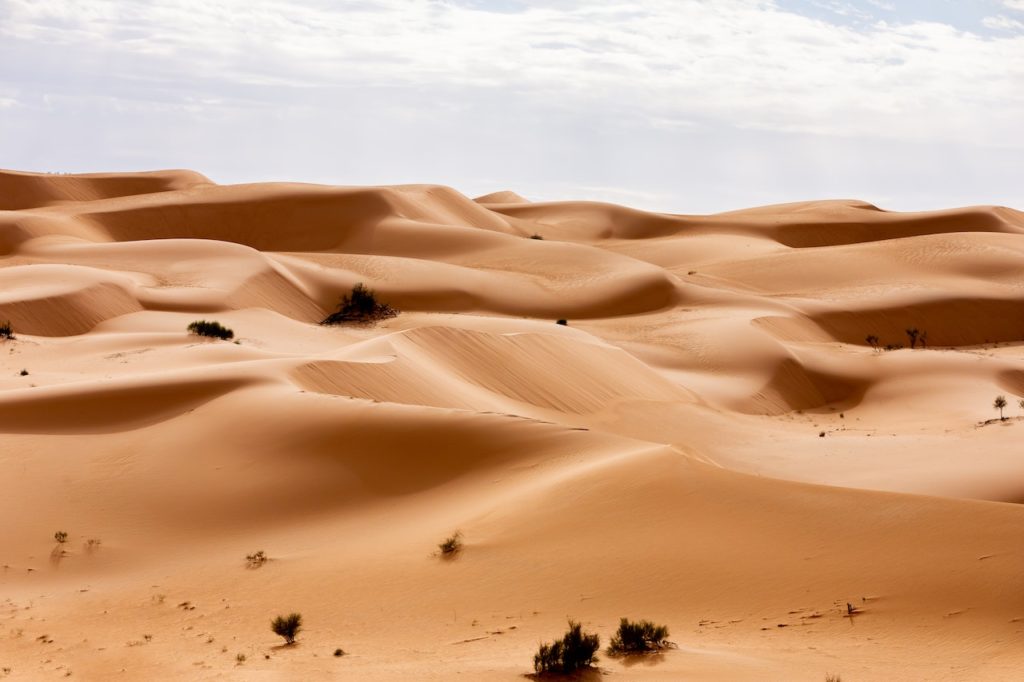
How long has the Sahara been a desert? Possibly for 4.6 million years, but maybe as long as 7 million years., The Sahara goes through a 41,000-year cycle.
The Sahara Desert is the largest hot desert on Earth. The largest deserts are actually the Antarctic and the Arctic deserts. The Sahara is 9.2 million square kilometers. The word sahara comes from the Arabic word for “desert”, so when we say the Sahara Desert, we are technically calling it the desert desert. The Sahara is so large and so reflective that it could theoretically be identifiable from another star in the Milky Way. In fact, it receives so much sun that solar panels covering 1.2% of the desert could technically provide all of the world’s power.
How long has the Sahara been a desert? Research indicates that it formed at least 4.6 million years ago. To work that out, researchers have looked at Saharan sand that has blown onto Fuerteventura and Gran Canaria Islands that are off the west coast of North Africa. Sand seasonally blows off the Sahara and lands on these islands. The researchers knew that the sand was from the Sahara because it was rich in quartz and mica, which do not appear on the islands but is common in the Sahara.
The sand that had blown from the Sahara was trapped in paleosols, which is an ancient layer in the ground. Researchers were able to date the paleosols because they were trapped between layers of lava, and lava contains isotopes that can be accurately dated. The layers of lava and Saharan sand alternated and the researchers dated the lava at the bottom to 4.6 million years ago. It is possible that the Sahara is older than that, but it certainly isn’t younger.
How did the Sahara form? There are several theories but two that seem to be the main ones. Both theories are that the Northern African monsoon weakened, triggering the formation of the desert. They differ in why it weakened. The first theory is that the monsoon weakened when the Tethys Ocean dried up about 7 million years ago. The second is that it weakened because of glaciation about three million years ago.
The Tethys Ocean was an ocean that lay between the ancient continents of Gondwana and Laurasia. As the landmasses came together, the Tethys Ocean shrank and was then cut off. As it dried up, it left behind the Mediterranean Sea and some of the other European seas. The theory is that as it dried up, there was less available water in North Africa and the monsoon weakened, causing the desert to form. The glaciation theory is similar but available water was trapped as ice and the monsoon weakened.
However the Sahara Desert formed, it is cyclical. The desert cycles between sandy desert and grassland with vegetation. As recently as 5000 BC, the Sahara Desert was a grassland that received enough rainfall. Several cultures lived and raised crops and cattle across the desert. In about 4000 BC the grassland became desert and some of these cultures were forced to move to the Nile river. One of them, the Nubian culture, would go on to be the Egyptians. The grassland became desert in the space of about 200 years, drastically altering the way that people lived.
What causes the Sahara Desert cycle? The Earth is tilted on its axis in relation to the sun at 23.5˚. This tilt is what causes our seasons. However, the Earth has a slight wobble and its tilt ranges from 22˚ to 24.5˚ over a 41,000-year period. This wobble is caused because of the gravitational pull of some of the other bodies in the solar system. 8000 years ago, roughly when the Sahara began to dry up, the tilt was 24.1˚. When the Earth was tilted at 24.1˚, the Northern Hemisphere was angled toward the sun in the summer months. That meant it was hotter in the summer and that created a low-pressure system over the Sahara which sucked moist air from the Atlantic, falling as rain over the Sahara. When the angle of the tilt changed, the Northern Hemisphere cooled down, the low-pressure system faded, and the wind began to blow from the Sahara out into the Atlantic. The African weather system changed, and the monsoon moved further south. This will repeat for as long as the continent of Africa is where it is, and the Sahara is predicted to be green again in about 15,000 years. I wonder if I will still be learning something every day when that happens.
So, how long has the Sahara been a desert? It became a desert somewhere between 7 and 4.2 million years ago, but it goes through cycles where it becomes grassland.
https://www.sciencedaily.com/releases/2019/09/190923101924.htm
https://en.wikipedia.org/wiki/Sahara
https://www.science.org/doi/10.1126/science.1120161
https://www.sciencedaily.com/releases/1999/07/990712080500.htm
https://www.space.com/10527-earth-orbit-shaped-sahara.html
https://www.sciencedaily.com/releases/2016/11/161130141053.htm
https://en.wikipedia.org/wiki/Tethys_Ocean
https://www.smithsonianmag.com/science-nature/sahara-millions-years-older-thought-180952735/
https://www.scientificamerican.com/article/how-the-sahara-was-born/

Pingback: #407 Can we cover the Sahara Desert in solar panels? - I Learned This Today